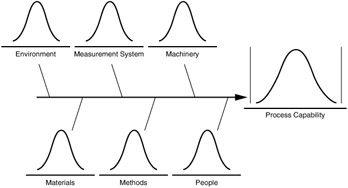Chapter 15: The Measurement Process
Product characteristics or process parameters are measured so that the performance of the manufacturing system can be assessed. The measured values provide a window to the manufacturing process and provide evidence that suggests that people settings be adjusted, tools replaced , fixtures redesigned, or the operation allowed to continue on its current course. The measurements allow decisions to be made that are critical to improvement efforts. These decisions are based on the information gleaned from the measurements. However, no measurement process is a set of perfect activities. Sometimes, different numbers or readings result when the same part or specimen is measured a second time. Different readings may be made by different people, different gauges, or testers, or by the same person using the same gauge. The difference in successive measurements of the same part is called measurements error. This source of variation must be analyzed because the validity of the data directly affects the validity of process improvement decisions. In this chapter, we will discuss this source of variation in a somewhat detailed fashion.
OVERVIEW
Measurement activities are a subset of the larger manufacturing process. Figure 15.1 shows a fishbone diagram that illustrates major parts of a manufacturing system. The individual components work together to form the manufacturing process. A process capability study includes all of the components of the process. Process potential studies focus on variation from only one part or component of the production system.

Figure 15.1: Process capability, the result of larger processes.
The measurement system is a major component of the manufacturing process. Studying variation in the measurement system is especially important because:
-
Measurement error contributes to process variation and has a negative influence on the process capability level.
-
Measurement error is present whenever measurements are made. The effects of measurement error influence the assessment of all other parts of the manufacturing process.
In addition to being a part of the manufacturing system, measurement activities also are part of a process. Parts or manufacturing process parameters are inputs to the measurement process (see Figure 15.2). Several components combine as the operation or activity of the measurements system. Data, readings, or measurements are the output from the measurement process.

Figure 15.2: The measurement process.
Figure 15.2 shows five major parts of the operation or activity of the measurements process. It is inappropriate to view measurement error as merely a function of measurement hardware or instruments. Other components of the measurement process are equally important to measurement error or validity.
People contribute to measurement error by having different levels of tactile, auditory, or visual perception. These characteristics account for calibration or interpretation differences.
Changing the method of using the measurement equipment produces measurement errors. This is frequently one of the largest sources of variation in the measurement process. This is especially true when different people or instruments are used to evaluate the same parts or process. A standard procedure is needed for every measurement activity. Only this procedure should be used by all people who operate test equipment. Measurement errors that are sometimes attributed to differences in people are actually due to differences in methodology. People are usually able to produce similar readings when they use the same methods for operating the measurement equipment.
Test equipment or hardware must be designed and made so that it is correct for the measurement task. The device must have the correct scale, proper load- bearing structure, and appropriate contact and holding surfaces. Measurement equipment must be made so that it is stable and able to produce reliable readings. Although the hardware is a component of the measurement process and a potential source of error, too often this component of the process is viewed as the only source of measurement variation. This is a dangerous perspective because no amount of hardware redesign or maintenance will reduce measurement errors that are due to differences in methods, people, or the reference.
The environment in which measurements are made also influences the validity of the readings. Changes in temperature, humidity, vibration , or other environmental factors can affect the test specimen or measurement equipment and influence the results. In addition to atmospheric and physical conditions, the environment in which measurements are made is influenced by people and their attitudes. Valid data are collected with test equipment only when people have adequate time and want to manipulate the parts and test equipment according to the standard procedure. The managerial environment and attitudinal conditions are potential sources of measurement errors.
Test equipment should be traceable to a known standard or reference. This is typically a standard set by a governmental agency or a physical phenomenon . When two test instruments are calibrated to the same standard, there is less error between the data that result from the different gauges.
Variation in the measurement system may be described as either common or special variation (see Chapter 6). Sources of special measurement variation must be identified, investigated, and eliminated. The level of measurement error (gauge capability) can only be quantified if the variation is stable, predictable, and due to common variation. As with other studies of variation, the capability level of the measuring system can be assessed only if it is stable and in control.
EAN: 2147483647
Pages: 181